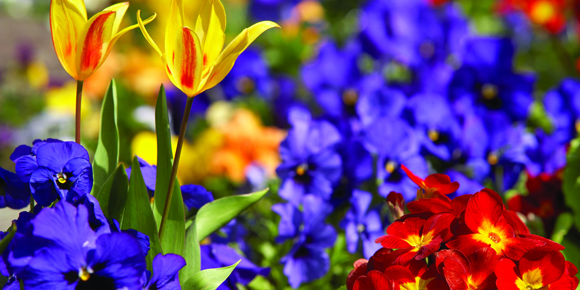Start now to plan to get your garden ready for the summer months ahead. With a little work in the coming month of May, you’ll be able to enjoy green grass, gorgeous flowers, and maybe even a great vegetable garden. Here’s what to do:
Aerate your lawn — Aeration involves perforating your lawn with hundreds of small holes that helps air, water and nutrients reach the roots. Think of it as giving your grass a way to breathe easier and drink more deeply. Aeration works best and is easiest to do when soil is moist, so wait until the day after a heavy rain or soak your yard with the sprinkler before getting started.
Spike aerators make holes by driving metal tines into the soil. More effective, however, are core aerators — consider renting one from your local hardware store or garden centre. A core aerator removes “plugs” of soil every 10 centimetres or so and deposits them on the lawn. Follow the same path as you would when mowing, covering your lawn both lengthwise and across.
Don’t worry about the plugs left behind when you’re done. They’ll break up on their own within a few weeks, or you can do it yourself with the back of a rake. Reseed, fertilize and water well once you’re done, and you’ll soon have a thick carpet of healthy green grass.
Fortify your flower beds — Spring is when the seedlings of invasive, weedy plants are just starting to grow, so remove as many as you can before they become established. You’ll also want to rake up any dead leaves and other debris left over from the winter.
Once you’ve whacked the weeds, cover flower beds with a layer of mulch to keep weeds from coming back. Mulch also helps retain moisture and keeps soil cool during intense summer heat. Whether you choose compost, wood chips, or another kind of mulch, you don’t want to skimp. Spread a layer at least five to seven centimetres thick around plants, shrubs and trees.
Make a plan for your plants — Want to grow delicious vegetables in your garden this summer? Perhaps you’d prefer an elegant collection of colourful flowers. Either way, now’s the time to think about what should go where, and get it in the ground.
When organizing flower beds, it’s often best to arrange things by height, with shorter plants at the front, medium-sized ones in the middle and taller ones at the back.
If you have a circular bed or an island bed in your garden, put taller plants in the centre and surround them with shorter ones. Rather than lining plants up in rigid rows, give some flow to your flowers by staggering different plants.
Add extra colour to a garden with a piece of sculpture or another object, say an old watering can or vase. Such items often act as an appealing focal point.
Practice proper pruning — Neaten trees and shrubs by pruning off dead branches and those that have been damaged by winter weather. Improve the overall health and shape of plants by trimming back old and weak shoots, wayward growth, and intersecting branches. This allows more light to penetrate the middle of the plant, making the central growth areas stronger.
Timing is important when pruning flowering plants, so make sure you know what you’re cutting. Plants that flower in spring, for instance, shouldn’t be cut back until after they’ve bloomed. Those that flower in summer are best pruned in late winter or early spring when they’re still mostly dormant.
If you’re not sure what you’re working with, it’s wise to wait until after the plant has flowered before pruning.
Bring in the birds and the bees — Give your garden an assist from Mother Nature by making it an attractive place for birds and bees. Birds help the health of your yard by consuming thousands of unwanted insects, while bees play a vital role by pollinating plants. This helps produce better yields of flowers, fruits and vegetables.
Make your garden more welcoming by including a birdbath. Put some stones in so bees have “islands” to rest on. Change the water regularly to ensure the bath doesn’t become a breeding ground for mosquitoes.
When deciding what to grow, choose seed-bearing and fruit-bearing plants to help bring in the birds. For bees, you’ll want plants that flower at different times so there’s always something for them to feed on. If space allows, try to group plants together in areas of about one square metre, which helps bees find the flowers more easily.
Finally, avoid using pesticides and herbicides, many of which contain chemicals that are toxic to bees and other beneficial insects.
— Smartmoves, Canada Post.



